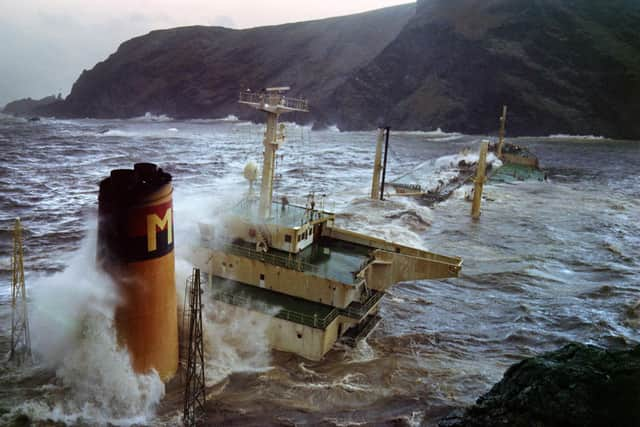Why the Braer disaster 30 years ago reminds us that our future cannot be in oil - Dr Richard Dixon
Just after 11am on 5th January 1993, the oil tanker MV Braer lost her battle with a massive storm and hit the rocks of Quendale Bay on the Shetland mainland.
The storm and tides continued to batter the tanker and eventually she broke in half, releasing all of the 85,000 tonnes of oil she was carrying over the course of six tense days.
Advertisement
Hide AdAdvertisement
Hide AdOf course, the long-term chronic problem of air pollution kills off around 2,000 people a year, and climate change is a much bigger general threat, but the Braer disaster was the biggest single pollution incident in Scotland’s history. It is in the top 20 largest tanker spills in the world, and the second largest in the UK after the Torrey Canyon in 1967.
Luckily the Braer was not carrying the normal treacly crude oil but Norwegian light crude oil, something like diesel fuel. Even more luck meant that the storm blew the oil away from the coastline and the rough seas dispersed it. Three years later, the Sea Empress went down on rocks off Milford Haven with a much greater impact even though the quantity of oil spilled was actually significantly less than for the Braer.
Despite this luck, at least 1,500 seabirds died and the local grey seal population was affected. You could smell the oil 20 miles away in Lerwick and locals reported experiencing breathing problems.
After years of argument, £45m was eventually paid out in compensation but fishing, and mussel and prawn harvesting restrictions continued until the year 2000.
Leaked papers suggested that the Braer was not seaworthy, indeed she was booked in to a repair yard immediately after her planned arrival in Canada. Under the UK’s 30-year rule the official papers withheld at the time will be released so we may learn more about what really went on in January 1993.


The Donaldson inquiry looked at the Braer disaster and recommended the stationing of powerful sea-going emergency tugs in strategic locations around the UK including Lerwick and Stornoway. Over the years these two have been reduced to only one tug based at Kirkwall.
When the Transocean Winner oil rig ran aground in the Western Isles in 2016, the Kirkwall tug was 12 hours steaming away. Even this tug was threatened with withdrawal in 2016 and only saved by a public campaign.
The impact of climate change on the North Atlantic is complex but, in general, climate change is putting more energy into storm systems, so there is a vicious circle of fossil fuel use increasing the risk to the tankers carrying those very fossil fuels.
Advertisement
Hide AdAdvertisement
Hide AdIt is not just tankers that lose oil. The North Sea oil industry accidentally released oil or gas 28 times in 2021, preliminary figures from the Health and Safety Executive show.
Ending oil production is the only sure way of ending the risk of oil spills. The climate crisis means that even conservative bodies like the International Energy Agency say that there should be no new production started up. Yet the UK plans to expand oil production over the next decade.
Dr Richard Dixon is an environmental campaigner and consultant